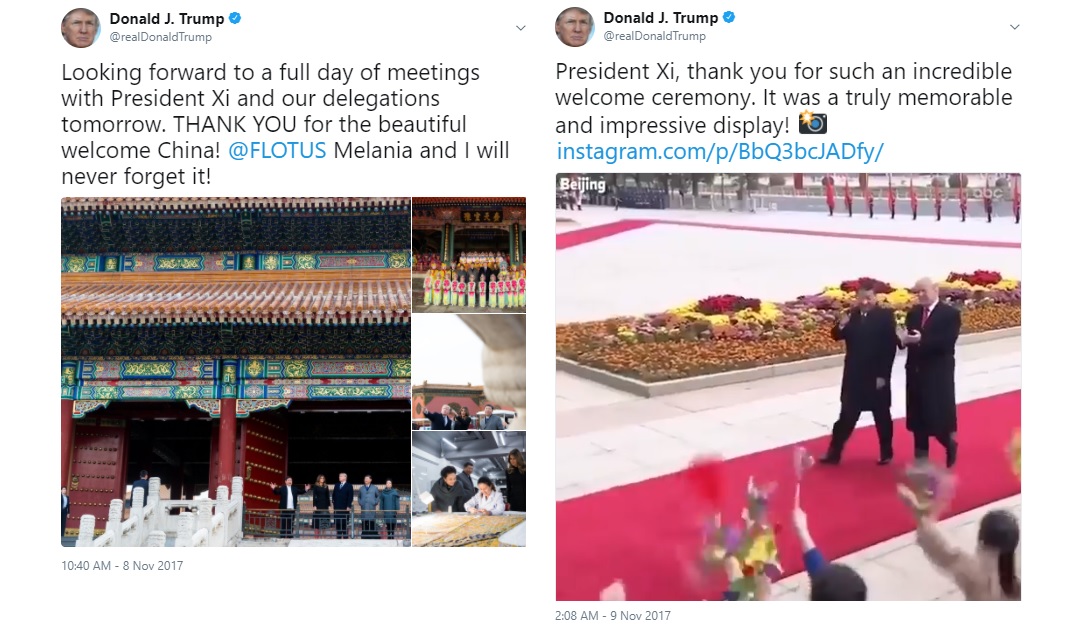![[CropImg]DOLLZocUQAEEZUW.jpg](/d/file/foreign-policy/2017-11-17/b7973172e5dcbaedf685dab8814dee6f.jpg)
In 2000, the then-business mogul Donald Trump published his third book, The America We Deserve, in which he wrote, “during the last decade of the Cold War, foreign policy was a big chess game. There was us, the U.S. and our close allies, and there was them, the Soviet Union.” He went on to contrast foreign policy in the Cold War with that of today: “we are the only major player. We deal with all the other nations of the world on a case-by-case basis.” He thus concluded, “the day of the chess player is over. American foreign policy has to be put in the hands of a dealmaker.”
Deal-making seems to lie at the core of Trump’s policy approach: his first book is titled The Art of the Deal; he has threatened U.S. withdrawal from NATO, the TPP and the Paris Climate Change Agreement because he considers the “deals” unfair; and when asked why he would make a great president, he responded, “because I am a dealmaker.”
Trump’s habit of incessant tweeting offers the outside world a glimpse of his worldview. In the past six years, Trump sent 36,200 tweets, and 437 of them were China-related. From a New York real estate mogul, to a presidential candidate, to the leader of the most powerful country in the world – how has Trump’s view on China changed, as is revealed through his 36,200 tweets?
Trump as businessman: China as the enemy and the greatest threat
From the first China-related tweet sent by Trump in 2012, to declaring his bid for the presidency in 2015, Trump as a real-estate developer reveals an open hostility against China. In 2011, Trump tweeted, “China is our enemy—they want to destroy us.” In 2013, his tweet read, “now China is helping Iran smuggle nuclear parts. China is not an ally but our country’s greatest threat & rival.”
“Enemy”, “threat” and “rival” are how Trump defined China at the time. His tweets reflected his view on the threat posed by China in three areas: jobs, trade and the military.
The topic of jobs, which shows up in Trump’s tweets 29 times during this period, is the word most frequently associated with China in Trump’s tweets. Ranking second is the word “currency.” Trump claims in one tweet that “the yuan has appreciated 40% against our dollar since 2005,” thus accusing Chinese workers of stealing jobs from Americans, leading to a “massive trade deficit.” “They are ripping us off,” Trump proclaimed. His grudge against the Chinese manufacturing industry was so strong that when reports came out of American Olympic athletes wearing “made in China” uniforms, Trump tweeted, “burn the uniform!”
The deal between China and the U.S. was unfair because “China was manipulating its currency,” Trump argued. "If China didn't play games with its currency and we played on a level economic playing field we could win easily.” For Trump, China was the secretive, cunning enemy that exploited the U.S. to achieve unfair trade advantage.
Apart from jobs and trade, China’s military buildup was meant to “intimidate the U.S.,” argued Trump. The word “military” appeared 14 times in his tweets. “China’s leadership is sneaky and underhanded, they significantly underreport their actual defense budget,” he tweeted in 2012. Trump falsely accused China of expanding military bases abroad in 2011 when there was no evidence of China doing so. He even justified his claim that “the purpose of China’s massive military buildup on the North’s border is to intimate us,” by citing the fact that “China attacked us during the Korean War.”
The relationship between China and the U.S., in the eyes of Trump, was not just a competition but a direct confrontation. China threatened to surpass the U.S. economically, had hostile intent and threatened U.S. national security.
Moreover, the idea of “America First” and a distaste for globalization was manifested clearly even in Trump’s early tweets. Trump believed that any international responsibility the U.S. undertook was giving an opportunity to China to surpass the U.S., whether it was preventing Ebola in Africa or tackling global climate change. As he thought, China was ripping wealth out of Africa and yet, as usual, refused to put anything back to help with Ebola. "Let the stupid Americans do it!" tweeted Trump in 2014.
Trump as presidential candidate: formulating his China strategy
From declaring his bid for the presidency on July 16th, 2015 to winning the presidency on November 7th, 2016, there was no significant change to Trump’s negative opinion of China. But his take on China was transformed from a mere impression to a concrete policy towards China, as is laid out in his tweets and campaign speeches.
“The first thing I would do, after becoming president, is to label China as currency manipulator,” Trump put it in his campaign speech in September 2015. He expressed a desire to increase the duty imposed on Chinese products so that “American workers can compete against Chinese workers” on an equal footing. After being pressed to specify to what extent he was willing to increase the duty on Chinese products, Trump finally gave a number in January 2016: it would be as high as 45 percent.
Apart from branding China as currency manipulator, Trump said, in order to strengthen the U.S.’ negotiation leverage, he would “strengthen the U.S. military and deploy it appropriately in the East and South China Sea.” This was meant to “show the strength” of the U.S., Trump argued, so that in renegotiating the trade deal with China, the U.S. could act from a position of strength.
In his book The Art of the Deal, Trump recalled his experience of buying a Boeing airplane. In 1987, the then real estate developer wanted to buy a Boeing 727 that was worth $30 million. Sensing that the seller was desperate, Trump offered a mere $5 million and was in the end able to secure the deal at just $8 million.
Negotiating in an aggressive manner seemed to be the tactic Trump offered. In his view, one should never refrain from making a bold and outlandish offer, because it gives one a “first mover” advantage to define the overall framework of the negotiation.

Trump as president: North Korea at the core of his China strategy
Although Trump boasted of his intent to label China a currency manipulator as his first action after becoming president, he has not yet done this, six months into his presidency. After his inauguration, he spoke less and less about trade issues with China. Ever since election night in 2016, of his 31 China-related tweets, only six of them have mentioned trade issues with China.
Ever since Trump became president, North Korea’s nuclear development has dominated his tweets. Eighteen of them have been about North Korea. He lambasted China for refusing to “rein in” North Korea: “China has been taking out massive amounts of money & wealth from the U.S. in totally one-sided trade, but won't help with North Korea. Nice!” Trump also considers the DPRK issue a problem that is easy for China to tackle. “China could solve this problem with one phone call- they love taunting us!” he tweeted.
However, everything started to change after Trump’s meeting with President Xi in Mar-a-Lago. It was reported that President Xi explained Chinese-Korean history to President Trump. “After listening for 10 minutes, I realized it was not so easy,” he told the Wall Street Journal. “North Korea is looking for trouble. If China decides to help that would be great. If not we will solve the problem without them!” tweeted Trump on April 11th, after Xi’s Mar-A-Lago visit. This stands in sharp contrast to Trump’s tone one month before, when he wrote, “China has done little to help!”
Apart from President Xi’s persuasion, China’s more aggressive approach towards the DPRK has certainly contributed to Trump’s softening tone. In April 2017, Reuters first reported that almost all coal shipments to the Chinese city of Dandong since February 2017 have been turned back, cutting one of the lifelines to the DPRK’s economy.
After the Mar-A-Lago visit, Trump started to link trade issues with the DPRK problem. Four days after, Trump tweeted, “I explained to the President of China that a trade deal with the U.S. will be far better for them if they solve the North Korean problem!” This marks the coming-of-age of Trump’s China strategy: a pragmatic, transactional approach towards the relationship. If China could offer help on issues Trump considers crucial to himself and to the interests of the U.S., he was willing to back down on other issues. On April 16th, Trump tweeted, “Why would I call China a currency manipulator when they are working with us on the North Korean problem?” The currency manipulation and trade issues were downgraded to secondary importance in the eyes of Trump. Even after North Korea launched missile tests four times in April, Trump did not bring up the old “China refused to act” rhetoric, but instead tweeted, “North Korea disrespected the wishes of China.”
On the issue of trade, Trump did not revert to his China-bashing tone. He articulated clearly in his interview with Wall Street Journal after the April Mar-A-Lago meeting that he would not label China as currency manipulator, and applauded China’s decision to “allow the U.S. to sell beef and other products to China.”
Trump’s visit to China
Trump’s friendly attitude towards China during his trip to Beijing must have surprised many American voters. Not only did he sing high praise of President Xi, he even changed his twitter background to a photo with President Xi and Madame Peng.
His speech after a signing ceremony between American companies and Chinese ones that secured deals worth $250 billion was the most surprising: “I don't blame China. After all, who can blame a country for being able to take advantage of another country for the benefit of its citizens? I give China great credit.”
On North Korea, Trump was no less conciliatory towards China. "President Xi …said he wants them to denuclearize. Progress is being made," Trump tweeted on November 12th. Since there has not yet been reports of China increasing its pressure on the DPRK, one can only speculate that the $250 billion trade, that broke historic records, pleased Trump tremendously.
The transformation of Trump’s China Strategy
Based on a textual analysis of Trump’s 36,200 tweets, one can see that Trump’s view on China transformed from viewing the country as an enemy and a threat— militarily and economically— to viewing China as a “partner” on solving the North Korean nuclear issue. In Trump’s eyes, the U.S.-China relationship evolved from zero-sum to having a basis in substantial common interests.
Trump’s foreign policy approach, which is one that deviates from the traditional liberal internationalism of the Washington establishment, has a significant business undertone—transactional at its core. As Trump lays out in The America we Deserve, “we are the only major player and we deal with all the other nations of the world on a case-by-case basis.” Trump is a supporter of issue linkage and there seems to be nothing in his mind that cannot be traded and negotiated.
Moreover, for Trump, there is always a clear winner. NPR contributor Adam Davidson wrote for The New York Times, “I have come to see him as a canny spokesman for a different sort of economy… his whole worldview is based on a rent-seeking vision of the economy, in which there’s a fixed amount of wealth that can only be redistributed, never grow.” Trump’s understanding of world trade is still reminiscent of the old rent-seeking economy.
If Trump is really as great a deal-maker as he claims to be, no one would be happier than Beijing. After all, with all its economic largess, Beijing has the most to offer in negotiating with the U.S. under Donald Trump.

